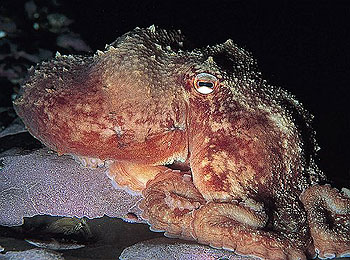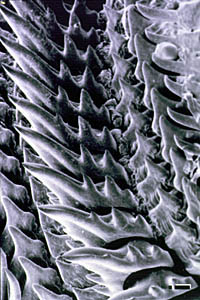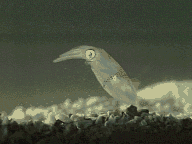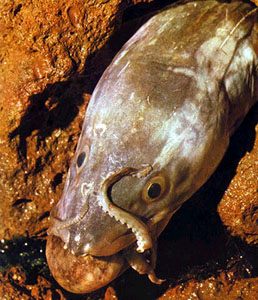 Lesser octopus (Eledone cirrhosa) from the North Sea. Photo: Courtesy of Erling Svensen. |
|
General:
|
Among the cephalopods there are the largest invertebrates on earth. Their nervous system is developed to a much higher degree than that of other molluscs. The complex behaviour of cephalopods makes them comparable to the vertebrates rather than to other invertebrates.
![]() Schematic body plan
of a cuttlefish (Sepia).
Schematic body plan
of a cuttlefish (Sepia).
The construction of their body shows that cephalopods are molluscs. They have no trace of a skeleton, neither internal nor external. Like that of other molluscs, cephalopods' bodies are divided in head, visceral sac and foot, the mantle (pallium) as a protective coat of the visceral sac.
The more modern cephalopods of the subclass called Coleoidea do not have an external shell like the other molluscs. Only members of the most ancient cephalopod groups, the subclass Nautiloidea with its only recent genus Nautilus, still swim the ocean with a shell resembling that of a snail. The rest of the cephalopods have an inner shell. That of the cuttlefish for instance is called cuttlebone, though it is neither bone nor skeleton, but a shell rest. Cuttlebones are known to the bird keeper to provide the bird with something to sharpen its beak. Mostly the spawn packets of squids and their inner shells are the only parts of them that can be found by somebody walking on the beach. Among some squids (Loligo) all that is left of the shell is a flexible rod, called a gladius, as it is formed like the ancient Roman legionary's sword.
 Cuttlebones of a common cuttlefish (Sepia officinalis) on a beach in Southern England. Picture: Trish Steel (Source). |
The most highly developed cephalopods are the octopuses. They have eight arms rather than ten like other squids. They are predators feared in the sea, because they can see very well (they have highly developed eyes like the vertebrates) and also very highly developed behavioural patterns. Also they have no shell to stop them from following their prey into the smallest holes.
 |
![]() Illustration left: Longitudinal cut through a
cephalopod's eye Picture:
Jan Parmentier.
Illustration left: Longitudinal cut through a
cephalopod's eye Picture:
Jan Parmentier.
Octopuses' eyes are among the most highly developed light sense organs in the animal kingdom. Like the vertebrates cephalopods have also developed lens eyes. In contrary, however, to the inverse eye of the vertebrates the cephalopods' eye is an everse one, meaning the sensory cells are the innermost layer of the retina. In human eyes the sensory cells build the retina's outermost layer, so that the light has to pass through several different cell layers before finally reaching the sensory region.
In cephalopods the eye develops from the endoderm, the inner embryonic cell layer. They develop as a bulb growing from the brain. The lens is built separately. A line of evolution can be shown from the simple pit shaped eye of ancient snails over the pinhole camera eye of a nautilus towards the lens eye of an octopus. The pinhole camera eye of the nautilus works like an medieval pinhole camera (Camera obscura). The light rays are broken by a small hole and thus project a picture on the rear end of the eye. By minimizing the hole the nautilus can sharpen the picture which, however, then becomes darker.
 Common cuttlefish (Sepia officinalis). Photo: Robert Patzner, Salzburg University . |
The name cephalopods meaning head-armed animals comes from the fact that cephalopods have several arms around their mouth protruding from their head. Squids and cuttlefish have ten arms, eight shorter ones and two long ones broadened at the end, which serve to catch their prey and to pull it towards the shorter arms, which then put the prey near the mouth. The Octopuses in contrary have got eight arms without the two long ones. (Octopus is Greek for eight-foot).
Cephalopod tentacles usually are full of suckers, with which they can hold their prey. The only cephalopod group without any suckers again are the nautiluses.
Around a cephalopods' suckers there are sensory cells providing it with information on its prey.
Feeding and Digestion:
 Cephalopod Radula Source: Cephalopoda Glossary. Picture: Mark Norman. |
Like other molluscs cephalopods have got a radula or rasp tongue to rasp their food to pieces. In addition to that they also have a beak made out of horn, like that of a parrot, with which the prey is cut to pieces before being swallowed. The beak can also serve to crack open the prey's armour, as many cephalopods' favourite food are crustaceans.
Octopuses could be said to have an external digestion. They bite open a crab's armour and afterwards spill digestion liquid over its internal organs. The liquid contains a nerve poison that paralyses the prey and proteases, enzymes, that digest its organs, so the crab's interior can be sucked by the octopus.
Gills:
Cephalopods breath by gills, as they belong to those mollusc groups which during their evolution never left the sea. Modern cephalopods have two gills, the ancient Nautilus group has four. So the class Cephalopoda systematically can be divided into Tetrabranchiata (= Nautiloidea, four gilled cephalopods, the ancient group) and Dibranchiata (= Coleoidea, two gilled cephalopods, the modern group).
So can be seen that the Nautilus group has several very ancient characteristics, as there are the gill apparatus with four gills, their external shell, the ancient less developed pinhole camera eyes. All these characteristics make them a so called living fossil.
 |
Locomotion and defence:
Some cephalopods (for example the octopus) walk along the ocean floor on their tentacles. Others, like cuttlefish, use their lateral fins to swim. Especially for evasion or retreat, cephalopods use a third kind of locomotion: They have developed a jet propulsion. The animal fills its mantle cavity with water and presses the water out of the cavity's opening with high speed. The funnel or sipho, a prolongation of the pallial opening, serves as direction control. Squids almost exclusively move by jet propulsion.
 On this picture a cuttlefish (Sepia) is hidden. Photo: Robert Patzner, Salzburg University . |
For defence squids also use ink, a dark liquid produced from a gland in the digestion system. It is then pressed out of the pallial opening. It confuses the attacker and even hampers its olfactory organs, so it cannot smell the squid. To the squid it gives enough time to retreat backwards at high speed. Some octopuses also use ink to confuse a prey (especially big ones, like lobsters) to afterwards attack it from behind.
Changing colours:
Many squids are also able to change their colour. They can control single pigment cells (chromatophores) and thus are capable of making different patterns and colours. For example squids ready to mate express that by a certain colour. So a squid should watch for its girl friend's colour, because she could eat him if she's not in the mood. Of course, colour change and shape change are also used to camouflage when hiding from enemies or ambushing prey.
|
Reproduction:
For reproduction the male squid produces a
special arm called a hectocotylus. With that he transfers a sperm packet to
the female's pallial cavity.
The picture on the right shows two bluering octopuses during the act of mating. The rear one is the male inserting its hectocotylus into the larger female's pallial cavity.
The female later lays a number of eggs, out of
which the small squid larvae hatch. More highly developed cephalopods, such as octopuses,
guard their eggs. They clean them, provide them with fresh water and defend
them against enemies. The female octopus does not eat as long a she guards
the eggs. Often she dies after her offspring's hatching, because she is too weak to defend herself
against her enemies.
 The sea eel (Conger conger) mainly feeds on cephalopods. Photo: Dubois. |
Cephalopods in the sea are as well hunters as prey. Their favourite food are fish and crustaceans such as crabs. On the other hand the nutritive cephalopods are also a well esteemed food for many other sea life creatures. Many fish, like moray eels, sharks, sea eels, but also whales like dolphins up to the huge cetaceans like the sperm whale, enrich their food with squids. Sperm whales dive into huge depths to hunt for the giant squid which reaches a secured length of 18 meters (more than 50 feet). Measuring the sucker scars on sperm whales' heads (it is thought that they try to ram the giant squid) it has been calculated, that there may be much bigger specimens in the deep sea. So far that is not known for sure, as with the whale's growth the scars grow as well. But in sperm whales' stomachs squid beaks have been found that also suggest giant squids of greater size in the deep sea. So probably we will never know how big cephalopods can really become.
Squids and their use to man
 Octopuses are hung in front of a seafood restaurant in Naxos, Greece. Photo: N. Gelfand, Stanford. |
To man squids are mainly of use as food. In different sea-side countries' kitchens squids and other cephalopods make an important part. Additionally squids are used as bait in fishery.
Squids' ink fluid also is of use in the cosmetics industry. Time ago in history it was also used to enhance black and white photographs. Of course today that is not needed any more, as most photographs today are in colour.
Cuttlebone of cuttlefish (Sepia) is used for cage birds to sharpen their beaks and provide them wit a lime source.
In fact, there is research to find more possibilities to use cephalopods' physiology for man. For example an enzyme in squids' neural systems is able to degrade certain neurotoxins. Also, squids are of great importance as research objects to neurobiology and ethology.
 |
In the meantime there has been the discovery that severed arms of octopuses can continue to function on their own, because they possess own autonomous neural knots or ganglia. Motion impulses are sent from the brain to the arm and there they trigger preserved neural responses controlling the arm's movement. For man, this is an interesting finding, for example with regard to robot science: Because of its limited motional possibilities, the human body is of relatively little interest as the original for the shape of a robot, An octopus, instead, could present science with some interesting ideas, especially concerning the autonomous movement of its arms.
![]() Thinking arms: Autonomous neural patterns
control the arms of octopuses.
Thinking arms: Autonomous neural patterns
control the arms of octopuses.
Legends:
Cephalopods are subject to countless legends and myths. The Swedish bishop Olaus Magnus mentions the "kraken" for the first time in the 16th century. Kraken is a Nordic word for an octopus. Since then the octopus has made a fool out of many naturalists and seafarers and thus became a legend. It is said that giant octopus can sink sail ships by grabbing their masts and pulling them underneath the surface. The French novelist Jules Verne mentions a giant squid in his book "20000 leagues under the seas". And even the ancient Greek poet Homer in his epic "Odyssey" mentions the Scylla, a sea monster with many legs that caught seamen from of Ulysses' ship.
What is interesting is, that the giant octopus Enteroctopus dolfleini reaches span widths of nine meters (about 30 feet), and reaches 250 kilograms. The biggest cephalopod, however, is a squid, the giant squid Architeuthis. The largest specimen of that cephalopod was found in 1933 on the coast of New Zealand and came to an overall weight of several tons and 22 meters overall length (66 feet).
So far no squid has provably been found that could attack a ship. It is imaginable that giant squids attack ships from below, mistaking them to be sperm whales.